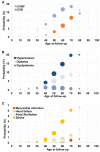Prevalence and prognosis significance of cardiovascular disease in cancer patients: a population-based study
- PMID: 31562288
- PMCID: PMC6781987
- DOI: 10.18632/aging.102301
Prevalence and prognosis significance of cardiovascular disease in cancer patients: a population-based study
Abstract
Background: Cardiovascular disease (CVD) is a heavy burden on cancer patients worldwide. This study aimed to evaluate the prevalence and influence of cardiovascular risk factors (CVRF) and CVD on the all-cause mortality among Chinese cancer patients.
Results: Overall, 13.0% of all cancer patients had at least one type of CVRFs and 5.0% with CVDs. Patients with CVRF or CVD presented more frequently at later stages and received higher percentage of oncotherapy. During 1,782,527 person-years of follow-up, the all-cause mortality in cancer patients with CVDs and with CVRFs was higher compared with those without (182.6/1000, 109.5/1000 and 93.3/1000 person-years, respectively). Cox regression analysis showed that patients with heart failure (HR 1.79, 95% CI 1.61-1.99), myocardial infarction (HR 1.50, 95% CI 1.16-1.95), atrial fibrillation (HR 1.30, 95% CI 1.09-1.53), stroke (HR 1.21, 95% CI 1.11-1.32), hypertension (HR 1.10, 95% CI 1.04-1.16) and diabetes (HR 1.16, 95% CI 1.08-1.24) had increased all-cause mortality, whereas dyslipidemia patients had better prognosis (HR 0.73, 95% CI 0.64-0.83). Stratified by cancer type, the prognostic impact of specific CVRF or CVD varied.
Methods: We consecutively recruited 710,170 cancer patients between Feb. 1995 and Jun. 2018. A stratified Cox proportional hazards model was used to analyze the effect of comorbidities on the overall survival of patients stratified by cancer type.
Conclusions: Cancer patients are vulnerable to comorbidity related to heart and cerebral disease. The influence of comorbidities on prognosis is noticeable and specific both for the type of cancer and comorbidities.
Keywords: cardiovascular disease; comorbidity; mortality; prevalence; tumor.
Conflict of interest statement
Figures





Similar articles
-
Impact of Cardiovascular Risk Factors and Cardiovascular Diseases on Outcomes in Patients Hospitalized with COVID-19 in Daegu Metropolitan City.J Korean Med Sci. 2021 Jan 11;36(2):e15. doi: 10.3346/jkms.2021.36.e15. J Korean Med Sci. 2021. PMID: 33429474 Free PMC article.
-
Even a Low Comorbidity Burden Predicts Poor Outcomes in Chronic Heart Failure.Crit Pathw Cardiol. 2024 Dec 1;23(4):189-195. doi: 10.1097/HPC.0000000000000368. Epub 2024 Jun 21. Crit Pathw Cardiol. 2024. PMID: 38905218
-
Burden of cardiovascular disease in Japanese cancer patients and survivors: a single cancer-center study in Niigata City.Int J Clin Oncol. 2019 Feb;24(2):196-210. doi: 10.1007/s10147-018-1341-0. Epub 2018 Sep 14. Int J Clin Oncol. 2019. PMID: 30218412 Clinical Trial.
-
Cardiovascular comorbidities and their prognostic value in small cell lung cancer patients with chemoradiotherapy.Clin Transl Oncol. 2024 Jun;26(6):1348-1356. doi: 10.1007/s12094-023-03359-3. Epub 2023 Dec 16. Clin Transl Oncol. 2024. PMID: 38103121
-
Risk of Cardiovascular Disease Associated with a Restless Legs Syndrome Diagnosis in a Retrospective Cohort Study from Kaiser Permanente Northern California.Sleep. 2015 Jul 1;38(7):1009-15. doi: 10.5665/sleep.4800. Sleep. 2015. PMID: 26083613 Free PMC article.
Cited by
-
Pre-existing cardiometabolic comorbidities and survival of middle-aged and elderly non-small cell lung cancer patients.J Geriatr Cardiol. 2023 Oct 28;20(10):737-747. doi: 10.26599/1671-5411.2023.10.002. J Geriatr Cardiol. 2023. PMID: 37970226 Free PMC article.
-
Postdischarge cancer and mortality in patients with coronary artery disease: a retrospective cohort study.J Geriatr Cardiol. 2025 May 28;22(6):578-586. doi: 10.26599/1671-5411.2025.06.006. J Geriatr Cardiol. 2025. PMID: 40636555 Free PMC article.
-
Relationship Between Serum Concentration of Adrenomedullin and Myocardial Ischemic T Wave Changes in Patients With Lung Cancer.Front Cardiovasc Med. 2022 Mar 7;9:836993. doi: 10.3389/fcvm.2022.836993. eCollection 2022. Front Cardiovasc Med. 2022. PMID: 35355972 Free PMC article.
-
Baseline cardiovascular comorbidities, and the influence on cancer treatment decision-making in women with breast cancer.Ecancermedicalscience. 2021 Sep 21;15:1293. doi: 10.3332/ecancer.2021.1293. eCollection 2021. Ecancermedicalscience. 2021. PMID: 34824616 Free PMC article.
-
Machine learning for cardio-oncology: predicting global longitudinal strain from conventional echocardiographic measurements in cancer patients.Cardiooncology. 2025 May 22;11(1):49. doi: 10.1186/s40959-025-00348-z. Cardiooncology. 2025. PMID: 40405236 Free PMC article.
References
-
- Wang H, Naghavi M, Allen C, Barber RM, Bhutta ZA, Carter A, Casey DC, Charlson FJ, Chen AZ, Coates MM, Coggeshall M, Dandona L, Dicker DJ, et al., and GBD 2015 Mortality and Causes of Death Collaborators. Global, regional, and national life expectancy, all-cause mortality, and cause-specific mortality for 249 causes of death, 1980-2015: a systematic analysis for the Global Burden of Disease Study 2015. Lancet. 2016; 388:1459–544. 10.1016/S0140-6736(16)31012-1 - DOI - PMC - PubMed
-
- Zhou M, Wang H, Zhu J, Chen W, Wang L, Liu S, Li Y, Wang L, Liu Y, Yin P, Liu J, Yu S, Tan F, et al.. Cause-specific mortality for 240 causes in China during 1990-2013: a systematic subnational analysis for the Global Burden of Disease Study 2013. Lancet. 2016; 387:251–72. 10.1016/S0140-6736(15)00551-6 - DOI - PubMed
-
- Edwards BK, Noone AM, Mariotto AB, Simard EP, Boscoe FP, Henley SJ, Jemal A, Cho H, Anderson RN, Kohler BA, Eheman CR, Ward EM. Annual Report to the Nation on the status of cancer, 1975-2010, featuring prevalence of comorbidity and impact on survival among persons with lung, colorectal, breast, or prostate cancer. Cancer. 2014; 120:1290–314. 10.1002/cncr.28509 - DOI - PMC - PubMed
Publication types
MeSH terms
LinkOut - more resources
Full Text Sources
Miscellaneous

